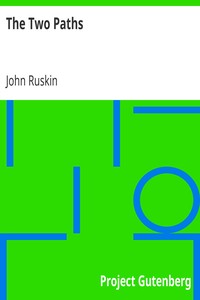| Author |
Ruskin, John, 1819-1900 |
| Title |
The Two Paths
|
| Note |
Reading ease score: 53.2 (10th to 12th grade). Somewhat difficult to read.
|
| Contents |
The deteriorative power of conventional art over nations -- The unity of art -- Modern manufacture and design -- The influence of imagination in architecture -- The work of iron, in nature, art, and policy.
|
| Credits |
Michelle Shephard, Eric Eldred, Charles Franks and the Online Distributed Proofreading Team
|
| Summary |
"The Two Paths" by John Ruskin is a series of lectures on art, its principles, and its impact on society, delivered in the mid-19th century. This work explores the relationship between art and its moral implications, focusing on how the practice of art can elevate or degrade nations and individuals. Ruskin discusses various schools of art and design while emphasizing the importance of observing and interpreting nature. At the start of the lectures, Ruskin reflects on the contrasting effects of art on the moral character of nations, particularly comparing the artistic expressions of India and Scotland. He notes that while Indian art is full of imaginative aesthetics, it often strays away from the natural world. In contrast, he highlights the nobility and virtue found in the Scottish people's connection to their natural landscape, seeing this as a crucial factor in shaping their moral disposition. Ruskin urges his audience to recognize the vital role of art in society and to choose paths that cultivate a genuine appreciation for natural beauty, as he believes this leads to both personal and societal growth. (This is an automatically generated summary.)
|
| Language |
English |
| LoC Class |
N: Fine Arts
|
| Subject |
Art
|
| Subject |
Decoration and ornament
|
| Subject |
Decorative arts
|
| Category |
Text |
| EBook-No. |
7291 |
| Release Date |
Jan 1, 2005 |
| Most Recently Updated |
Dec 30, 2020 |
| Copyright Status |
Public domain in the USA. |
| Downloads |
242 downloads in the last 30 days. |
|
Project Gutenberg eBooks are always free!
|

